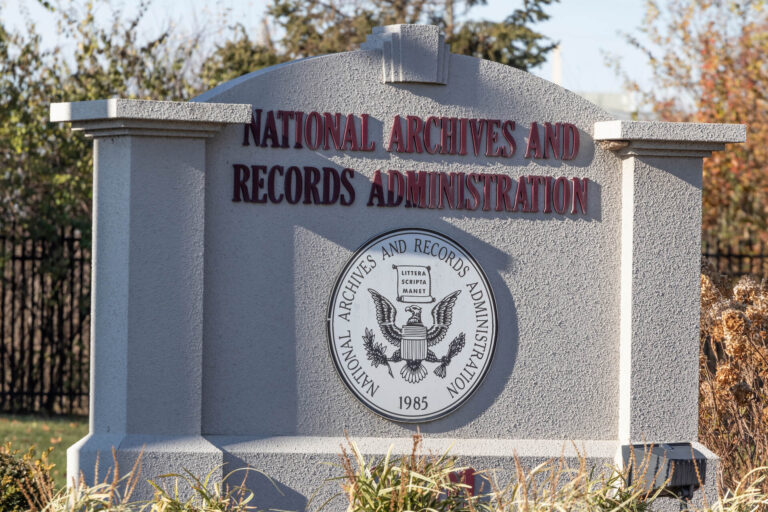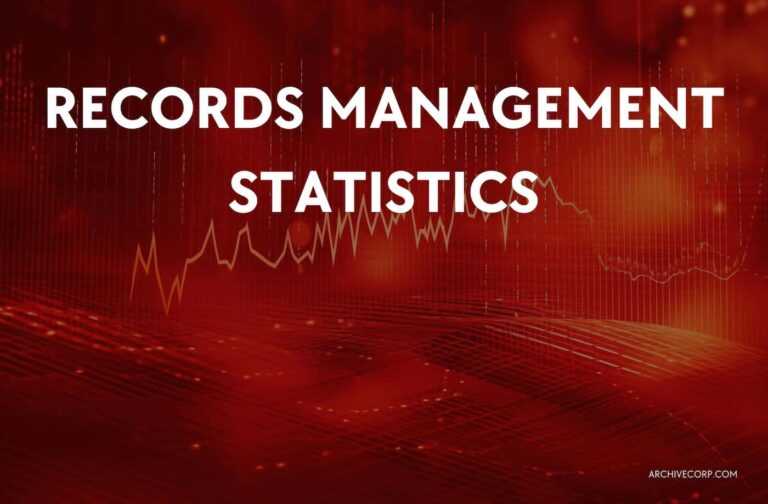9 Effortless Ways to Improve Records Management for More Efficient Record Keeping
Learning how to improve records management has become compulsory for businesses aiming for operational efficiency and compliance.
Imagine otherwise losing an important contract among stacks of unorganized papers or perhaps years of research data becoming inaccessible because of inadequate backup measures. The risk of legal penalties and reputational damage due to non-compliant record-keeping practices is even more alarming.
Records management is meant to mitigate all that by following an organized process of creating, maintaining, and disposing company data. The records range from tangible documents like contracts and invoices to digital files such as databases, spreadsheets, and emails.
The real challenge is managing such entries effectively throughout their lifecycle while maintaining easy access, secure storage, and proper disposal protocols.
Today, we’ll try to change that narrative by walking you through practical strategies for improving your records management system. We’ll cover everything from efficient filing methods to advanced digital document management tools.
Key Takeaways
In this guide, you’ll discover effortless ways to improve your records management. We emphasize efficient filing systems, advocating for color-coding, alphabetical organization, and clear hierarchies. Regular record audits, tailored to your organization’s size, will keep your data tidy. When it comes to storage, we discuss shelving, cabinets, offsite options, and the merits of digitization. For physical records, secure shredding is essential, and you’ll also explore the benefits of outsourcing your records management. Digitally, we delve into document management software, retention policies, and data security. Finally, we guide you through the process of outsourcing electronic records management, including the advantages of cloud storage and seamless data migration.
5 Ways to Improve Your Physical Records Management
1. Implement an Efficient Filing System
When documents are systematically arranged, retrieval becomes a breeze, errors are minimized, and the chances of misplacing vital records are significantly reduced.
One of the most effective ways to maintain this order is file indexing. You can organize your records using uniform color-coding, alphabetical, or numerical systems.
For instance, color-coding accelerates document retrieval by visually guiding users to specific sections. Alphabetical systems, however, are intuitive and work best when dealing with names or titles. Although they might need some acclimatization, Numerical systems could help with large volumes of records.
Whatever you settle for, remember to implement a clear filing hierarchy additionally. Each index should have a structured pathway from broad categories to individual files.
For example, within the “Finance” category, you might have sub-categories like “Invoices,” “Tax Documents,” and “Payroll.”
Here are the records management best practices to follow while at it.
2. Regularly Conduct Record Audits
Regularly reviewing your records management system, you get to identify inefficiencies, redundancies, and gaps. This helps to eliminate irrelevant documents and keep your storage streamlined.
For thorough audits, you might want to follow a standardized checklist that covers every aspect – from document verification to storage assessment. You could have tasks such as “Verify document indexing accuracy,” “Examine the physical condition of records,” and “Evaluate storage capacity utilization.”
As for the frequency of the audits largely depends on your organization’s size and record volume. Large organizations or those in fast-paced sectors might need quarterly audits. At the same time, smaller or more stable entities could opt for bi-annual or annual reviews.
3. Invest in Quality Storage Solutions
Proper storage preserves record integrity, ensures longevity, and facilitates swift retrieval. Think of it as neatly organizing tools on a pegboard rather than haphazardly tossing them into a shed.
Regarding physical records, there are several storage options to consider. Traditional shelving might be suitable for frequently accessed files, while lockable cabinets offer an added layer of security for sensitive documents. But what about those seldom retrieved records that need to be retained for extended periods?
You could otherwise use offsite storage for infrequently accessed records that must be retained for long durations. Archive Corp has a secure environment with climate control, full-time surveillance, and protection against natural disasters.
To further streamline retrieval, consider digital archiving. This is where you convert physical records into a digital format, conserving space and expediting data access. With a simple search, digital archives can pull up documents that would have otherwise taken hours to locate manually.
4. Secure Shredding and Document Destruction
While record keeping is critical, so is knowing when and how to dispose of them. Improper disposal can otherwise trigger a wide range of problems – from breaches that expose sensitive information to hefty penalties for non-compliance with data protection regulations.
One reliable document disposal method is shredding. It obliterates information, so it becomes impossible to piece it back together.
The shredding itself shouldn’t be conducted arbitrarily. Instead, consider following standardized document destruction protocols. Such guidelines specify which documents to destroy, the timing, and the method.
For instance, financial records might have a different retention period compared to employee records.
Consider adopting these recommended best practices in records management and shredding for optimal results.
5. Outsourcing Physical Records Management
When organizations outsource records management, they gain access to expertise and advanced technology that might be unattainable in-house. This gives them more secure storage, faster retrieval times, and improved records management.
And then there’s the cost factor. Maintaining an in-house records management team, with all the associated overheads, can be expensive. Outsourcing often presents a more cost-effective solution, with businesses only paying for the services they need.
Outsourcing also takes the guesswork out of document destruction. When a document’s lifecycle ends, your records management company proceeds to dispose of it securely while complying with all relevant regulations.
Of course, the benefits of outsourcing are only as good as the provider you choose. So, you should qualify potential partners by their experience in the field, client testimonials, certifications, and technological capabilities. Here’s even a step-by-step guide on choosing the right records management company.
4 Ways to Improve Your Electronic and Digital Records Management
1. Implement Robust Digital Document Management Software
With features like Optical Character Recognition (OCR), document management software converts scanned documents into machine-readable text. You then get to capitalize on its metadata tagging for accurate categorization and swift retrieval of documents.
The software’s full-text search capability allows users to scan and quickly pinpoint specific content within documents. On the other hand, version control tracks and accesses multiple document iterations to facilitate data recovery.
Your digital document management software should also contain security features such as encryption, offsite storage, and role-based access controls that restrict sensitive documents to authorized personnel.
Integrating the software with your other business systems – including CRM, ERP, and HRM- can amplify that power. The resultant link would streamline operations, minimize redundancies, and boost productivity.
2. Develop a Comprehensive Retention Policy
Every document, whether physical or digital, has a lifecycle. This is where a retention policy comes in, as it dictates the duration for which records should be kept and provides guidelines for their secure disposal once they’ve outlived their relevance.
Your retention policy should, above everything else, comply with government regulations. Many jurisdictions have set different durations for retaining various types of records, especially those related to financial transactions or personal details. Failing to comply could lead to hefty penalties, legal complications, and reputational damage.
The retention policy itself should be periodically reviewed and updated. This keeps it aligned with the ever-changing laws and business environment.
Nevertheless, a policy is only as good as its implementation. Employees, in particular, must be well-versed with the retention guidelines – as they are the primary custodians of records. So, you might need to invest in their training or work with a records management company offering complimentary sessions.
3. Ensure Data Security and Compliance
Electronic records, while efficient, are susceptible to numerous security threats – including ransomware, phishing schemes, and unauthorized access.
One particularly effective frontline defense is encryption. It uses advanced cryptographic techniques to transform data into a cipher, which remains unreadable if intercepted. This form of protection is especially critical for sensitive information, such as financial transactions, personal identification details, and proprietary business data.
Another strategy that could help is conducting regular security audits across your records management infrastructure, software, and user practices. You should be able to identify their weak points through penetration testing and vulnerability assessments.
There’s also the aspect of compliance. By adhering to industry regulations, you’ll be preserving data integrity while avoiding legal repercussions.
Keep in mind, though, that even with all the above best practices, security incidents are still imminent. You thus need a solid disaster recovery plan to fall back on in the event of a breach. It would minimize data loss and reputational damage.
4. Outsourcing Electronic Records Management
Partnering with specialized records management providers would grant your company innovative, secure, high-performance infrastructure and software.
For instance, you may appreciate cloud backup’s convenience and scalability. They allow you to adjust your storage needs as the organization grows, archive data to offsite data centers, as well as remotely restore lost data.
However, transitioning to an outsourced model requires strategic planning, mapping, and execution – especially if the data is in physical form. This is where you bring in specialized document scanning services to perform the migration while maintaining the integrity and structure of your records.
To find an outsourcing partner with such capabilities, you must go beyond the obvious considerations of cost and capability. Pay special attention to their security protocols, data backup and recovery mechanisms, compliance with industry regulations, etc.
Drive Efficiency and Success with Improved Records Management
Efficiency in records management translates to a host of positive business outcomes.
For instance, by enabling swift data retrieval, records management can speed up decision-making processes and enhance both customer service and overall productivity.”
From a financial standpoint, the advantages are just as significant. “Efficient records management reduces costs associated with both physical and digital storage. It also means fewer resources are used to correct errors, and businesses get to avoid hefty non-compliance penalties.
You can kickstart your journey with this essential records management checklist. But, for optimal benefits and minimal risks, consider partnering with a reputable records management company.
Archive Corp has extensive experience in managing both physical and digital records. We offer advanced solutions for the entire document lifecycle, all while maintaining full compliance with data regulations. Get in touch today for customized solutions.




![The Ultimate A-Z Records Management Checklist [2023]](https://www.archivecorp.com/wp-content/uploads/2023/06/records-management-checklist-archivecorp-1-768x504.jpg)


